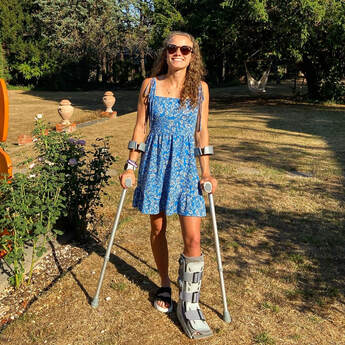|
When it comes to injury, it can be difficult to know what you can and can’t do. As a general rule, however the injury feels, in the early stages, I believe it is always better to underdo it than overdo it. The most important thing is recovery and healing, and the less you do, the better the healing process will be in these early days. I am still not weight bearing, so if I wonder if it’s ok to do or not, it’s probably not. Less is more. So, what have I been able to do since getting my fracture? *it is important to note I have had guidance from professional, experienced physios regarding this, and it is imperative you listen to your physio as every injury is different and cannot be treated the same as another. In terms of cardio based work, I have done a blend of the bike and aqua jogging. My time on the bike has been very limited and minimal due to reducing the amount of contact my foot has with another surface. I have been doing no more than 30 minutes continuous on the bike. 30 minutes is the limit, so a bit less is always better. I have been told by the physio that a little bit of foot contact is good to promote bone healing, but any more is counter productive. I don’t want to do anything that will prolong the healing process, so I have been sure to stick to this and hold back. Aqua jogging for me is where it is at when injured. There is no weight bearing, therefore the sight of injury is not being stressed. What is aqua jogging? Put simply, it is running in the water without your feet touching the ground. You can do it either with or without a float around your middle, but I usually use the float. The float can be very beneficial as it allows you to keep your posture upright and focus on working hard instead of worrying what your body position is doing. You do not want to learn forward too much and you want to stay as upright as possible. It is also worth ensuring your hands are not being used as paddles, as that makes it easier and a less effective workout for your body.
Aqua jogging is also best done in water out of your depth. You do not want your feet to touch the ground, therefore the deeper the water the better. This can be in a pool, but I have also done it in the sea and a lake to spice it up and keep it interesting. To keep the pool work interesting, I tend to imitate a road workout. For example, this may be repetitions of 3 minutes. You could do 6-10 of these with one minute recovery. Other sessions include sets of 60 secs, 45 secs, 30 sec, 15 sec with the following rep time as recovery. When aqua jogging, I aim to keep the recovery short and rarely go over a minute. This keeps the heart rate high and gives you a solid session. I have also done a small amount of conditioning a few times a week. This has included a little bit of core, some upper body work, and a small bit of glute work set by the physio. This is to maintain a little bit of running conditioning. The most important thing I CAN do however, is REST. No form of activity is going to help as much as rest is, so this is always priority.
0 Comments
Leave a Reply. |
Hannah IrwinI love to run and I love to write, so I write about running! Archives
March 2023
Categories |


 RSS Feed
RSS Feed
